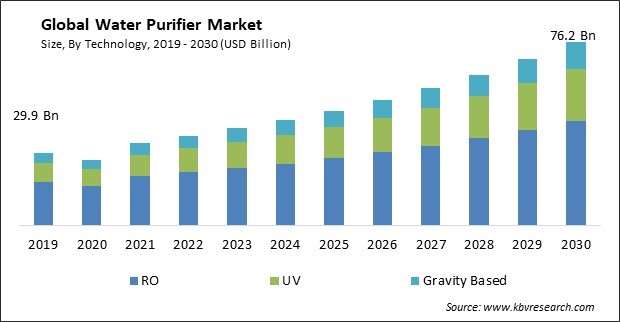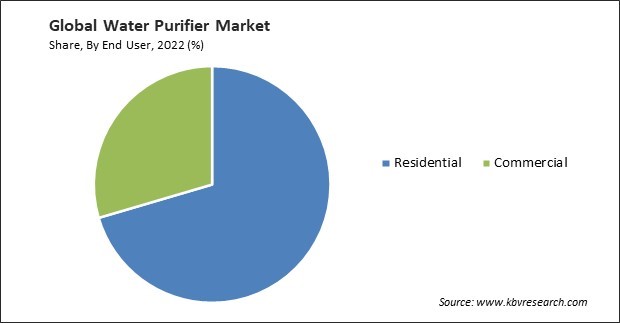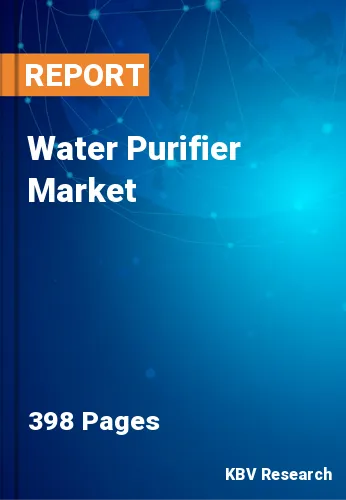The Global Water Purifier Market size is expected to reach $76.2 billion by 2030, rising at a market growth of 9.5% CAGR during the forecast period. In the year 2022, the market attained a volume of 1,08,095.3 thousand units experiencing a growth of 9.2% (2019-2022).
Industries, commercial establishments, and businesses are required to adhere to specific water quality standards set by regulatory bodies. Consequently, the commercial segment would generate approximately 33% share of the market by 2030. With the increasing focus on health and hygiene, businesses and institutions are more concerned about providing clean water to their employees, students, patients, and visitors, leading to the installation of water purification systems in commercial settings. Some of the factors affecting the market are increasing disposable incomes in several nations, continuous advancements in water purification technologies, and cost and affordability challenges in various regions.

Rising disposable incomes mean that a more significant segment of the population can allocate a portion of their budget to non-essential but desirable items, such as water purifiers. As the affordability of these appliances increases, more consumers are willing to invest in technologies that enhance their quality of life. With higher incomes, consumers reevaluate what they consider essential for a comfortable and healthy lifestyle. Urban dwellers with higher incomes are more likely to invest in home appliances that contribute to a modern and convenient lifestyle, including water purifiers. Moreover, Technological innovations have led to more efficient water purification methods. For example, UV (Ultraviolet) purification systems use ultraviolet light to disinfect water by inactivating bacteria, viruses, and other microorganisms. RO (Reverse Osmosis) systems use a semipermeable membrane to remove many impurities. These aspects will pose lucrative growth prospects for the market in the upcoming years.
However, High initial costs can deter consumers, particularly in lower-income regions, from investing in water purifiers. The expense of purchasing and installing a water purification system could be a financial burden for households or communities with limited resources. This results in lower adoption rates within these segments of the population. Lower affordability restricts the market from reaching a broader consumer base. In addition, ongoing maintenance costs, filter replacements, and electricity expenses can add to the overall operational cost of using water purifiers. These aspects will limit the growth of the market in the coming years.
Based on technology, the market is segmented into gravity based, UV, and RO. In 2022, the UV segment garnered a significant revenue share in the market. Ongoing technological advancements improved the efficiency and affordability of UV purification systems, making them more accessible to a broader market. UV purifiers offer a chemical-free water purification method, which appeals to consumers looking for environmentally friendly and low-maintenance solutions. Government regulations and initiatives in various regions to ensure clean and safe drinking water have further boosted the adoption of water purification systems, including UV technology. Therefore, these aspects will help in the expansion of the segment.
On the basis of end user, the market is bifurcated into commercial and residential. The residential segment recorded the maximum revenue share in the market in 2022. Consumers are increasingly more concerned about the quality of the water they drink. Awareness regarding waterborne diseases and the presence of contaminants in tap water has led to a growing demand for home water purification systems. With increasing urbanization, more people are living in apartments or smaller households where having a personal water purification system is convenient and necessary. Urban dwellers, mainly, are inclined to invest in home water purifiers as a direct solution to ensure clean drinking water. Owing to these factors, the segment will grow rapidly in the coming years.

By portability, the market is divided into non portable and portable. The portable segment procured a remarkable growth rate in the market in 2022. The demand for portable water purifiers is high among travelers, hikers, campers, and adventurers who require access to safe drinking water in remote or outdoor locations. People living in small apartments or moving frequently also prefer portable purifiers due to their smaller size and ease of transport. Moreover, in regions susceptible to natural disasters or where access to clean water is limited during emergencies, portable purifiers become essential for immediate water purification.
Based on distribution channel, the market is divided into retail stores, direct sales, and online. The retail stores segment recorded the maximum revenue share in the market in 2022. The availability of water purifiers in retail stores, both physical and online, has made them more accessible to a wider consumer base. Consumers can explore various options, compare products, and make informed decisions. Retail stores often offer various water purifiers from different brands, with varying features and price points, allowing consumers to select products that best fit their specific needs and budget. Owing to these factors, the segment will expand rapidly in the coming years.
| Report Attribute | Details |
|---|---|
| Market size value in 2022 | USD 37.2 Billion |
| Market size forecast in 2030 | USD 76.2 Billion |
| Base Year | 2022 |
| Historical Period | 2019 to 2021 |
| Forecast Period | 2023 to 2030 |
| Revenue Growth Rate | CAGR of 9.5% from 2023 to 2030 |
| Number of Pages | 398 |
| Number of Table | 830 |
| Quantitative Data | Volume in Thousand Units, Revenue in USD Billion, and CAGR from 2019 to 2030 |
| Report coverage | Market Trends, Revenue Estimation and Forecast, Segmentation Analysis, Regional and Country Breakdown, Porter’s 5 Forces Analysis, Company Profiling, Companies Strategic Developments, SWOT Analysis, Winning Imperatives |
| Segments covered | Portability, Technology, Distribution Channel, End User, Region |
| Country scope |
|
| Companies Included | Pentair PLC, Kent Ro System Ltd., Panasonic Holdings Corporation, A. O. Smith Corporation, Unilever PLC, General Electric Company, Tata Chemicals Ltd., Brita Gmbh (Brita Group), Best Water Technology Group, LG Electronics, Inc. (LG Corporation) |
| Growth Drivers |
|
| Restraints |
|
By region, the market is segmented into North America, Europe, Asia Pacific, and LAMEA. In 2022, the Europe segment acquired a considerable revenue share in the market. Consumers in Europe were becoming increasingly aware of the importance of clean and safe drinking water. Concerns about waterborne diseases and the quality of tap water have led to a surge in the adoption of water purification systems. The European Union's stringent regulations and standards regarding water quality and safety have also contributed to the market's growth. Compliance with these standards and regulations encouraged the adoption of water purification systems. Therefore, the segment will expand rapidly in the future.
Free Valuable Insights: Global Water Purifier Market size to reach USD 76.2 Billion by 2030
The market research report covers the analysis of key stakeholders of the market. Key companies profiled in the report include Pentair PLC, Kent Ro System Ltd., Panasonic Holdings Corporation, A. O. Smith Corporation, Unilever PLC, General Electric Company, Tata Chemicals Ltd., Brita Gmbh (Brita Group), Best Water Technology Group, LG Electronics, Inc. (LG Corporation)
By Technology (Volume, Thousand Units, USD Million, 2019-2030)
By End User (Volume, Thousand Units, USD Million, 2019-2030)
By Portability (Volume, Thousand Units, USD Million, 2019-2030)
By Distribution Channel (Volume, Thousand Units, USD Million, 2019-2030)
By Geography (Volume, Thousand Units, USD Million, 2019-2030)
This Market size is expected to reach $76.2 billion by 2030.
Increasing disposable incomes in several nations are driving the Market in coming years, however, Cost and affordability challenges in various regions restraints the growth of the Market.
Pentair PLC, Kent Ro System Ltd., Panasonic Holdings Corporation, A. O. Smith Corporation, Unilever PLC, General Electric Company, Tata Chemicals Ltd., Brita Gmbh (Brita Group), Best Water Technology Group, LG Electronics, Inc. (LG Corporation)
In the year 2022, the market attained a volume of 1,08,095.3 thousand units experiencing a growth of 9.2% (2019-2022).
The Non-Portable segment is leading the Market, By Portability in 2022there by, achieving a market value of $65.6 billion by 2030.
The Asia Pacific region dominated the Market, By Region in 2022, and would continue to be a dominant market till 2030;there by, achieving a market value of $32.39 billion by 2030.
Our team of dedicated experts can provide you with attractive expansion opportunities for your business.

